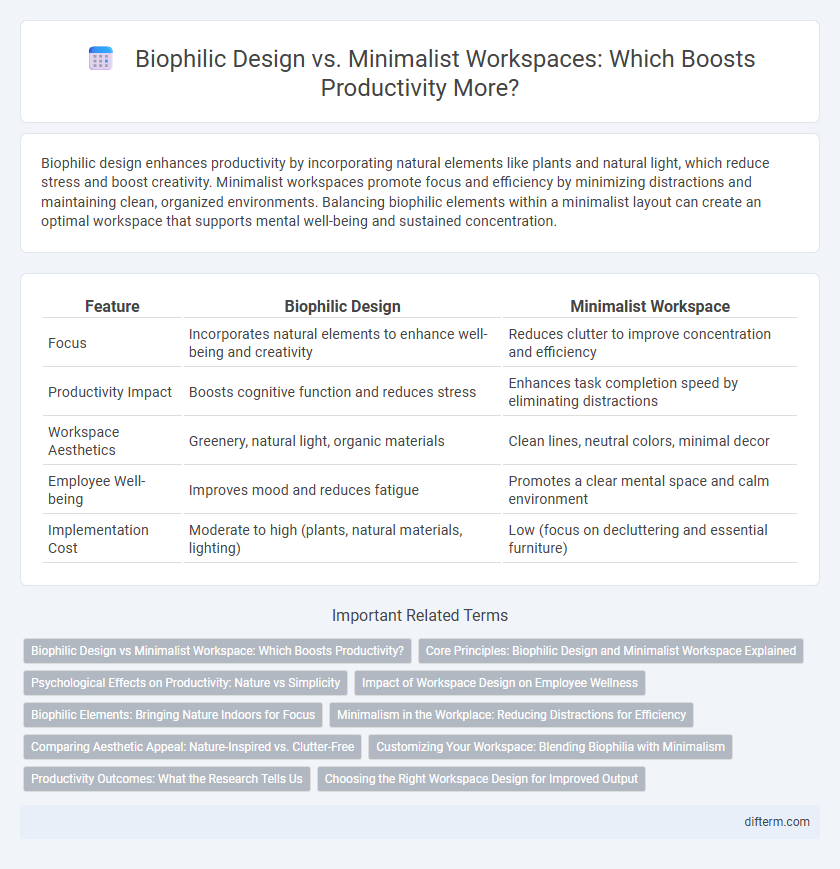Biophilic design enhances productivity by incorporating natural elements like plants and natural light, which reduce stress and boost creativity. Minimalist workspaces promote focus and efficiency by minimizing distractions and maintaining clean, organized environments. Balancing biophilic elements within a minimalist layout can create an optimal workspace that supports mental well-being and sustained concentration.
Table of Comparison
| Feature | Biophilic Design | Minimalist Workspace |
|---|---|---|
| Focus | Incorporates natural elements to enhance well-being and creativity | Reduces clutter to improve concentration and efficiency |
| Productivity Impact | Boosts cognitive function and reduces stress | Enhances task completion speed by eliminating distractions |
| Workspace Aesthetics | Greenery, natural light, organic materials | Clean lines, neutral colors, minimal decor |
| Employee Well-being | Improves mood and reduces fatigue | Promotes a clear mental space and calm environment |
| Implementation Cost | Moderate to high (plants, natural materials, lighting) | Low (focus on decluttering and essential furniture) |
Biophilic Design vs Minimalist Workspace: Which Boosts Productivity?
Biophilic design enhances productivity by integrating natural elements such as plants, natural light, and organic materials, which reduce stress and improve cognitive function. Minimalist workspaces promote focus and efficiency through clutter-free environments and simplified layouts, minimizing distractions. Studies show biophilic environments can increase creativity and well-being, while minimalist spaces support task-oriented productivity, making the ideal choice dependent on individual work style and job demands.
Core Principles: Biophilic Design and Minimalist Workspace Explained
Biophilic design integrates natural elements such as plants, natural light, and organic materials to enhance wellbeing and cognitive function, fostering a connection with nature that improves productivity. Minimalist workspaces emphasize decluttered environments, clean lines, and essential furnishings to reduce distractions and promote mental clarity. Both approaches prioritize optimizing focus and comfort but differ in their foundational principles--biophilic design centers on natural stimuli, while minimalism advocates simplicity and order.
Psychological Effects on Productivity: Nature vs Simplicity
Biophilic design enhances productivity by integrating natural elements such as plants, natural light, and organic materials, which reduce stress and improve cognitive function. Minimalist workspaces promote focus and efficiency through clutter-free environments that limit distractions and encourage organized workflows. Psychological studies reveal that while biophilic spaces boost creativity and well-being by connecting workers to nature, minimalist spaces foster mental clarity and task-oriented productivity by emphasizing simplicity.
Impact of Workspace Design on Employee Wellness
Biophilic design integrates natural elements like plants, natural light, and organic materials, which has been shown to reduce stress and increase overall employee well-being, enhancing productivity by fostering a calm and revitalizing environment. In contrast, minimalist workspaces emphasize simplicity and decluttered surfaces, promoting focus and reducing distractions, though they may lack the restorative benefits provided by nature-inspired settings. Studies indicate that incorporating biophilic elements in office design outperforms minimalist layouts in boosting mental health and job satisfaction, directly impacting employee wellness and productivity.
Biophilic Elements: Bringing Nature Indoors for Focus
Biophilic design integrates natural elements such as plants, natural light, and organic materials to enhance focus and cognitive function in workspaces. Studies show that exposure to greenery and natural textures reduces stress and improves productivity compared to minimalist environments that prioritize simplicity but lack sensory stimulation. Incorporating biophilic elements boosts employee well-being and creativity, making it a strategic choice for optimizing workplace performance.
Minimalism in the Workplace: Reducing Distractions for Efficiency
Minimalism in the workplace enhances productivity by eliminating clutter and reducing visual distractions, allowing employees to maintain focus on essential tasks. Clean, organized spaces with streamlined furniture and minimal decor promote mental clarity and improve efficiency. Studies show that minimalist work environments contribute to lower stress levels and faster decision-making, ultimately boosting overall performance.
Comparing Aesthetic Appeal: Nature-Inspired vs. Clutter-Free
Biophilic design enhances productivity by incorporating natural elements such as plants, natural light, and organic textures, creating a calming environment that reduces stress and boosts creativity. In contrast, minimalist workspaces focus on clutter-free, streamlined aesthetics with clean lines and neutral colors that promote focus and efficiency by minimizing distractions. Both designs improve workspace appeal, but biophilic design emphasizes warmth and vitality, while minimalist spaces prioritize simplicity and order.
Customizing Your Workspace: Blending Biophilia with Minimalism
Customizing your workspace by blending biophilic design with minimalist principles enhances productivity by integrating natural elements like plants and natural light with clean, clutter-free surfaces. This synergy promotes mental clarity and reduces stress while maintaining functionality and aesthetic simplicity. Incorporating organic textures and greenery within a streamlined environment fosters focus and creativity, optimizing workflow efficiency.
Productivity Outcomes: What the Research Tells Us
Research indicates that biophilic design, which incorporates natural elements such as plants, natural light, and organic materials, significantly enhances cognitive function and reduces stress, leading to improved productivity outcomes. In contrast, minimalist workspaces promote focus through decluttering and simplicity but may lack the restorative benefits found in biophilic environments. Studies show that integrating biophilic elements within a minimalist framework maximizes productivity by balancing mental clarity with psychological well-being.
Choosing the Right Workspace Design for Improved Output
Biophilic design integrates natural elements such as plants, natural light, and earthy materials, enhancing cognitive function and reducing stress, which leads to increased productivity. Minimalist workspaces emphasize decluttering and simplicity, promoting focus and efficiency by eliminating distractions. Selecting the right workspace design depends on individual work styles and tasks, as biophilic spaces benefit creativity and well-being, while minimalist environments support concentration and task completion.
Biophilic design vs Minimalist workspace Infographic

 difterm.com
difterm.com